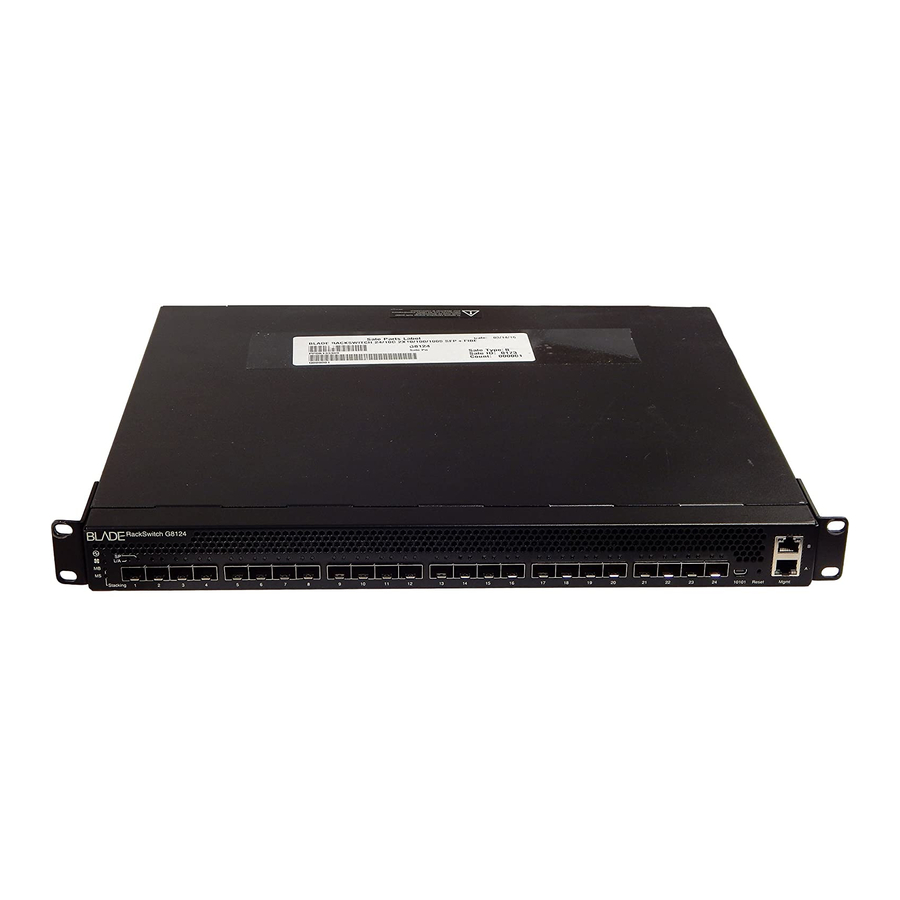
Blade Network Technologies BLADEOS RackSwitch G8124 Manuals
Manuals and User Guides for Blade Network Technologies BLADEOS RackSwitch G8124. We have 3 Blade Network Technologies BLADEOS RackSwitch G8124 manuals available for free PDF download: Application Manual, Installation Manual, Quick Manual
Blade Network Technologies BLADEOS RackSwitch G8124 Application Manual (388 pages)
BLADEOS 6.5
Brand: Blade Network Technologies
|
Category: Switch
|
Size: 3 MB
Table of Contents
-
Preface
17 -
-
-
-
IP Routing49
-
-
-
-
-
VLAN Maps82
-
-
-
VLAN Numbers88
-
PVID Numbers89
-
-
VLAN Tagging90
-
-
STP/PVST+ Mode111
-
Port States111
-
-
-
Qos Overview133
-
-
-
VE Capacity166
-
VM Group Types166
-
Local VM Groups167
-
VLAN Maps176
-
-
Vcenter Ves183
-
-
-
-
-
Dhcp Relay Agent227
-
-
Ipv6 Limitations230
-
Unicast Address232
-
Ipv6 Interfaces234
-
-
-
Stability243
-
Routing Updates244
-
Ripv1244
-
Ripv2244
-
RIP Features245
-
-
IGMP Snooping250
-
IGMP Groups251
-
Fastleave251
-
Igmpv3 Snooping251
-
-
IGMP Querier255
-
IGMP Filtering256
-
-
-
BGP Attributes266
-
Chapter 20: OSPF
273-
Ospfv2 Overview273
-
-
Defining Areas279
-
Interface Cost281
-
Default Routes282
-
Virtual Links283
-
Router ID283
-
Authentication284
-
-
-
PIM Overview303
-
-
-
Hot Links318
-
Forward Delay318
-
Preemption318
-
FDB Update318
-
-
-
Health Checks321
-
FDB Flush321
-
-
-
VRRP Overview332
-
Failover Methods334
-
-
-
LLDP Overview345
-
-
-
SNMP Version 1355
-
SNMP Mibs361
-
-
Index
383
Advertisement
Blade Network Technologies BLADEOS RackSwitch G8124 Installation Manual (52 pages)
Brand: Blade Network Technologies
|
Category: Switch
|
Size: 2 MB
Table of Contents
-
Preface
5 -
-
-
-
Reset Button11
-
-
Switch Ports12
-
Console Port14
-
Leds15
-
Blade Network Technologies BLADEOS RackSwitch G8124 Quick Manual (28 pages)
BBI Quick Guide
Brand: Blade Network Technologies
|
Category: Switch
|
Size: 1 MB
Table of Contents
-
Preface
5 -
-
Toolbar16
-
Context Tabs16
-
Commands16
-
-
Forms Window18
-
Advertisement
Advertisement


